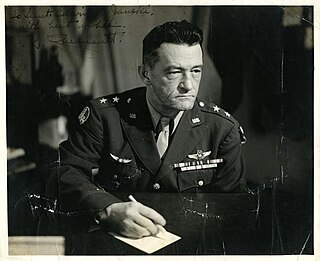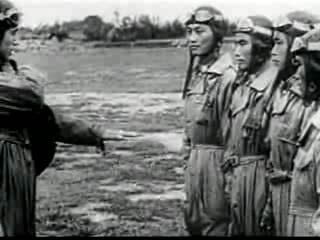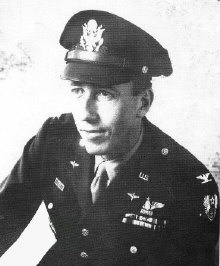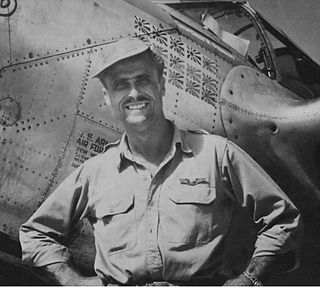Related Research Articles

The Curtiss P-40 Warhawk is an American single-engined, single-seat, all-metal fighter-bomber that first flew in 1938. The P-40 design was a modification of the previous Curtiss P-36 Hawk which reduced development time and enabled a rapid entry into production and operational service. The Warhawk was used by most Allied powers during World War II, and remained in frontline service until the end of the war. It was the third most-produced American fighter of World War II, after the North American P-51 Mustang and Republic P-47 Thunderbolt; by November 1944, when production of the P-40 ceased, 13,738 had been built, all at Curtiss-Wright Corporation's main production facilities in Buffalo, New York.

The First American Volunteer Group (AVG) of the Republic of China Air Force, nicknamed the Flying Tigers, was formed to help oppose the Japanese invasion of China. Operating in 1941–1942, it was composed of pilots from the United States Army Air Corps (USAAC), Navy (USN), and Marine Corps (USMC), and was commanded by Claire Lee Chennault. Their Curtiss P-40B Warhawk aircraft, marked with Chinese colors, flew under American control. Recruited under President Franklin Roosevelt's authority before Pearl Harbor, their mission was to bomb Japan and defend the Republic of China, but many delays meant the AVG first flew in combat after the US and Japan declared war.

The American Volunteer Groups were volunteer air units organized by the United States government to aid the Nationalist government of China against Japan in the Second Sino-Japanese War. The only unit to actually see combat was the 1st AVG, popularly known as the Flying Tigers.

Albert John "Ajax" Baumler was an American fighter ace during the Spanish Civil War and World War II.

David Lee "Tex" Hill was an American fighter pilot and triple flying ace. He is credited with 12+1⁄4 victories as a squadron leader with the Flying Tigers and another six as an officer in the United States Army Air Corps in World War II. He retired as a brigadier general.

The Second Sino-Japanese War began on 7 July 1937 with the Marco Polo Bridge incident in the Republic of China and is often regarded as the start of World War II as full-scale warfare erupted with the Battle of Shanghai, and ending when the Empire of Japan surrendered to the Allies in August 1945. The Chinese Air Force faced the Imperial Japanese Army and Navy Air Forces and engaged them in many aerial interceptions, including the interception of massed terror-bombing strikes on civilian targets, attacking on each other's ground forces and military assets in all manners of air interdiction and close air support; these battles in the Chinese skies were the largest air battles fought since World War I, and featured the first-ever extensive and prolonged deployment of aircraft carrier fleets launching preemptive strikes in support of expeditionary and occupation forces, and demonstrated the technological shift from the latest biplane fighter designs to the modern monoplane fighter designs on both sides of the conflict.

Edward Franklin Rector was a colonel in the United States Air Force, a fighter ace of World War II, and a member of the Flying Tigers.

Flying Tigers is a 1942 American black-and-white war film drama from Republic Pictures that was produced by Edmund Grainger, directed by David Miller, and stars John Wayne, John Carroll, and Anna Lee.

Neel Ernest Kearby was a United States Army Air Forces colonel and P-47 Thunderbolt pilot in World War II who received the Medal of Honor for his actions in combat. Kearby is the first United States Army Air Forces fighter pilot to have received the Medal of Honor. He scored 22 aerial victories and was the top-scoring P-47 pilot in the Pacific Theater.

James Howell Howard (April 8, 1913 – March 18, 1995) was a general in the United States Air Force and one of just two fighter pilots in the European Theater of Operations in World War II to receive the Medal of Honor—the United States military's highest decoration. Howard was an ace in two operational theaters during World War II, with six kills over Asia with the Flying Tigers of the American Volunteer Group (AVG) in the Pacific, and six kills over Europe with the United States Army Air Forces. CBS commentator Andy Rooney, then a wartime reporter for Stars and Stripes, called Howard's exploits "the greatest fighter pilot story of World War II". In later life, Howard was a successful businessman, author, and airport director.

Robert Tharp (R.T.) Smith was an American World War II fighter pilot and ace, credited with 8.7, 8.9 or 9 Japanese aircraft while fighting with the American Volunteer Group.

John Van Kuren "Scarsdale Jack" Newkirk was a United States naval aviator and squadron leader with the 1st American Volunteer Group (AVG), also known as the Flying Tigers, who may have led the first American offensive mission of World War II. Most of his combat experience was during the defense of Rangoon, Burma, from Japanese air attacks. After the fall of Rangoon, his unit was operating from within China when he set off on his final mission, as part of an attack on Japanese airfields in Thailand.

Gerald Richard Johnson was a World War II flying ace who flew for the United States Army Air Forces. Johnson commanded the 9th Fighter Squadron and 49th Fighter Group, and became the fourth ranking fighter ace in the Pacific during World War II. He ended his war career with 22 kills.

Thomas Joseph Lynch was a United States Army Air Forces lieutenant colonel and a flying ace of World War II. After joining the United States Army Air Corps in 1940, Lynch flew the Bell P-39 Airacobra with the 39th Pursuit Squadron. After the attack on Pearl Harbor, the squadron was deployed to Australia and then to Port Moresby in early 1942.

Robert Burdette Westbrook was a United States Army Air Forces lieutenant colonel and a World War II flying ace. Westbrook commanded the 44th Fighter Squadron, and became the leading fighter ace of the Thirteenth Air Force. He is also the ninth ranking fighter ace in the Pacific during World War II and also one of ten United States Army Air Forces pilots who became an ace in two different types of fighter aircraft.

Lieutenant Colonel George Bray McMillan was a United States Army Air Forces fighter pilot, Squadron Commander, combat "ace" and member of the American Volunteer Group better known as the Flying Tigers.

William Douglas Dunham was an American flying ace in the 348th Fighter Group during World War II, scoring 16 aerial victories. He retired from the United States Air Force in 1970 at the rank of brigadier general.

Cyril Filcher Homer was a United States Army Air Force fighter ace who was credited with shooting down 15 aircraft during World War II.

Stephen Jacob Bonner Jr. was an American flying ace in the 23rd Fighter Group during World War II.
References
- 1 2 "D. F. C. on Son's Behalf Will Go to Bob Little's Mother". Spokane Daily Chronicle . July 27, 1943.
- ↑ "American Volunteer Group Aces, World War II, 1939–1945". American Fighter Aces Association (americanfighteraces.org). Archived from the original on November 5, 2014. Retrieved February 23, 2016.
- 1 2 3 4 5 Samson, Jack (December 20, 2011). Flying Tiger: The True Story of General Claire Chennault and the U.S. 14th Air Force in China. Lyons Press. p. 191. ISBN 9780762795437 . Retrieved February 23, 2016.
- 1 2 3 4 5 6 Clements, Terrill J.; Laurier, Jim (February 20, 2013). American Volunteer Group 'Flying Tigers' Aces. Osprey Publishing. p. 68. ISBN 9781472800596 . Retrieved February 23, 2016.[ permanent dead link ]
- ↑ Olynyk, Frank J. AVG & USAAF (China-Burma-India Theater) Credits for Destruction of Enemy Aircraft in Air to Air Combat, World War 2. Aurora, Ohio: Privately published, 1986. Figures obtained from warbirdforum.com.
- ↑ "Boyhood Chum of Bob Little Tells of Hero's Activities". Spokane Daily Chronicle. July 18, 1942.
- ↑ Tracy Ellig (September 6, 2000). "Tale of heroism is finally told". The Spokesman-Review .